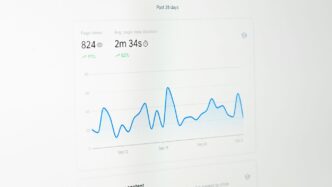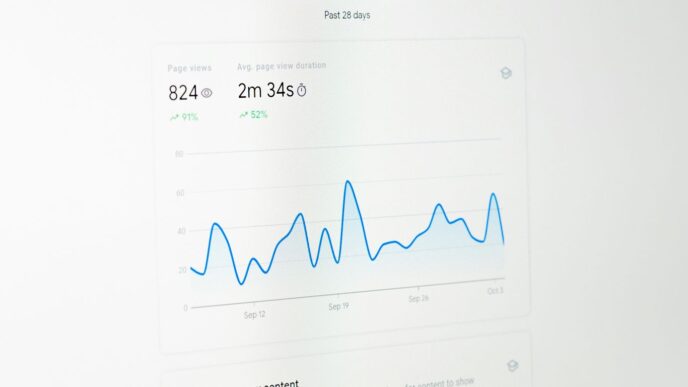Defining Generative AI and Predictive AI
So, you’ve heard a lot about AI lately, right? It feels like it’s everywhere. But not all AI is the same. Think of it like tools in a toolbox – you wouldn’t use a hammer to screw in a bolt. Two big players in the AI world are Generative AI and Predictive AI, and they do pretty different jobs.
Generative AI: The Digital Creator
Generative AI is the artist, the writer, the composer of the digital world. Its main gig is to create new stuff. You give it a bunch of examples – like text, images, or music – and it learns the patterns. Then, it uses those patterns to make something entirely original. It’s not just copying; it’s synthesizing. It’s like teaching a chef to cook by showing them thousands of recipes, and then they invent a brand new dish. Tools like ChatGPT, which can write stories or emails, or Midjourney, which creates images from text descriptions, are prime examples. They take what they’ve learned and build something that didn’t exist before.
Predictive AI: The Digital Forecaster
Predictive AI, on the other hand, is more like a fortune teller or a detective. Its job is to look at past and present data and make educated guesses about what’s going to happen next. Think about when Netflix suggests a show you might like, or when your bank flags a suspicious transaction. That’s predictive AI at work. It analyzes mountains of historical information to spot trends and probabilities. It’s all about forecasting outcomes, identifying risks, or recommending actions based on what the data suggests.
Core Purpose: Creation Versus Foresight
The fundamental difference boils down to their core purpose. Generative AI is built for creation – making new content, ideas, or designs. Predictive AI is built for foresight – anticipating future events or behaviors. They operate on different principles:
- Generative AI: Learns patterns to produce novel outputs.
- Predictive AI: Learns patterns to forecast future probabilities.
While generative AI is busy dreaming up new possibilities, predictive AI is busy calculating the likelihood of those possibilities, or other future events, actually happening. It’s a bit like the difference between an author writing a new novel and a critic predicting which books will be bestsellers.
How Each AI Type Operates

Generative AI’s Pattern Synthesis
Generative AI works by learning the underlying patterns and structures within vast amounts of data. Think of it like an artist studying thousands of paintings to understand brushstrokes, color palettes, and composition. It doesn’t just memorize; it internalizes the essence of the data. When you ask it to create something new, it uses this learned knowledge to synthesize novel outputs that resemble the training data but aren’t direct copies. This process often involves complex neural networks, like Generative Adversarial Networks (GANs) or Transformer models, where one part of the AI might try to create content, and another part tries to tell if it’s real or fake. This back-and-forth helps it get really good at producing realistic results.
Predictive AI’s Data-Driven Guesses
Predictive AI, on the other hand, is all about looking at historical data to make educated guesses about the future. It’s less about creating something entirely new and more about identifying trends and probabilities. Imagine a weather forecaster looking at past weather patterns, current atmospheric conditions, and satellite imagery to predict if it will rain tomorrow. Predictive AI uses statistical models and algorithms to analyze input data and identify relationships. It then uses these relationships to forecast future events or classify new data points. The goal is to provide an answer or a probability based on what has happened before.
Underlying Models and Architectures
While the lines can sometimes blur, the core mechanisms differ. Generative AI often relies on models like:
- Generative Adversarial Networks (GANs): Two neural networks (a generator and a discriminator) compete, with the generator creating data and the discriminator trying to distinguish it from real data. This competition drives the generator to produce increasingly realistic outputs.
- Transformer Models: These are particularly good at handling sequential data like text, allowing them to understand context and generate coherent responses or creative writing.
Predictive AI typically employs models such as:
- Regression Models: Used to predict continuous values, like sales figures or stock prices.
- Classification Models (e.g., Decision Trees, Support Vector Machines): Used to categorize data into predefined classes, such as identifying fraudulent transactions or predicting customer churn.
Here’s a simplified look at their operational focus:
| AI Type | Primary Operation |
|---|---|
| Generative AI | Synthesizing new data based on learned patterns |
| Predictive AI | Forecasting future outcomes or classifying data |
Key Differentiators in Functionality
So, we’ve talked about what these two types of AI are and how they work, but what really sets them apart in terms of what they do? It boils down to their output and what they’re good at.
Output: Novel Content vs. Future Probabilities
Generative AI is all about making new stuff. Think of it as a digital artist or writer. It takes what it’s learned from vast amounts of data and uses that to create entirely new text, images, music, or even code. The output is original, something that didn’t exist before in that exact form. Predictive AI, on the other hand, is more like a digital fortune teller. It looks at past data, finds patterns, and then tells you what’s likely to happen next. It’s not creating something new; it’s forecasting a specific outcome based on historical trends. The core difference is creation versus prediction.
Strengths: Creativity and Originality
Generative AI shines when you need something novel. Need a blog post draft? A unique image for a social media campaign? A piece of music for a video? Generative AI can do that. Its strength lies in its ability to synthesize information and produce creative, often surprising, results. It’s fantastic for tasks where imagination and originality are key, pushing the boundaries of what’s possible in content creation and design.
Strengths: Accuracy and Data Insights
Predictive AI’s superpower is accuracy and understanding what the data is telling us about the future. It’s built to identify subtle patterns in historical information that humans might miss. This makes it incredibly useful for:
- Risk Assessment: Figuring out the likelihood of loan defaults or insurance claims.
- Forecasting: Predicting sales figures, stock market movements, or equipment failures.
- Personalization: Recommending products or content based on past behavior.
While generative AI is about making new things, predictive AI is about making informed guesses about what’s coming next, backed by solid data analysis. It’s less about flair and more about reliable foresight.
Industry Applications and Use Cases
Generative AI in Content and Design
Generative AI is really shaking things up when it comes to creating new stuff. Think about it: instead of a human spending hours writing marketing copy, a generative AI can whip up a bunch of options in minutes. Tools like ChatGPT can draft blog posts, social media updates, or even product descriptions. It’s not just text, either. Generative AI can also create images, music, and even video snippets. For designers, this means faster prototyping. They can use tools like Midjourney or DALL-E to quickly visualize different concepts for logos, website layouts, or app interfaces. This speeds up the whole creative process, letting designers focus on refining the best ideas rather than starting from scratch every time.
Here’s a quick look at what it can do:
- Automated Content Creation: Drafting articles, emails, ad copy, and social media posts.
- Visual Asset Generation: Creating unique images, illustrations, and design mockups.
- Code Assistance: Suggesting code snippets or even generating basic functions for developers.
- Personalized Experiences: Generating tailored responses for chatbots or customized product recommendations.
Predictive AI in Risk and Forecasting
Predictive AI, on the other hand, is all about looking into the future based on past data. It’s like having a crystal ball, but powered by numbers. Businesses use it for all sorts of things, especially when there’s a lot of data involved and many decisions to make. For example, in healthcare, it can help figure out which patients might need extra checks before they leave the hospital. In the energy sector, it can point to the best spots for drilling. Transportation companies use it to predict when train parts might fail, saving them from costly breakdowns. And in finance, it’s used for things like spotting fraudulent transactions or deciding if someone is likely to repay a loan.
Predictive AI is particularly good at identifying patterns that humans might miss in large datasets.
Some common areas where predictive AI shines include:
- Fraud Detection: Identifying suspicious transactions in real-time.
- Customer Retention: Figuring out which customers are likely to leave and why, so you can try to keep them.
- Equipment Maintenance: Predicting when machinery might break down so it can be fixed before it stops working.
- Sales Forecasting: Estimating future sales based on historical data and market trends.
Synergistic Use Across Sectors
It’s not always an either/or situation. Often, generative AI and predictive AI can work together to achieve even better results. Imagine a marketing team. They could use predictive AI to figure out which customer segments are most likely to respond to a new product. Then, they could use generative AI to create personalized marketing messages and visuals specifically for those segments. This combination allows for highly targeted and creative campaigns. In customer service, predictive AI might identify a customer who is likely to be unhappy, and then generative AI could draft a personalized apology or offer to help resolve the issue. This blend of foresight and creation can lead to more efficient operations and happier customers across many different industries.
Technical Demands and Data Requirements

So, you’re thinking about building or using one of these AI systems? It’s good to know what they actually need to run. It turns out, generative AI and predictive AI are pretty different when it comes to the hardware and the data they gobble up.
Processing Power and Infrastructure Needs
Generative AI, the kind that makes new stuff like text or images, is a real power hog. Think of it like needing a super-computer for every task. These models are massive, and to get them to work, you usually need a whole bunch of specialized graphics cards (GPUs), like NVIDIA’s A100s or H100s. We’re talking about servers packed with these, needing tons of fast memory, special cooling systems to stop them from overheating, and serious power management. It’s not something you can just run on your average laptop.
Predictive AI, on the other hand, is usually much more down-to-earth. A lot of predictive tasks can get by with standard computer processors (CPUs) or maybe a single GPU if things get a bit more complex. You can often use cloud services that scale up or down as needed, or even run some simpler predictive models on devices right where the action is happening, like on a factory floor or in a car. This difference in hardware needs really impacts how much it costs to get these systems up and running.
Data Dependency: Quality Versus Quantity
When it comes to data, these two AI types have very different appetites. Generative AI models are like data gluttons. They need absolutely enormous amounts of data – we’re talking billions of data points – to learn and create something new and coherent. While they can benefit from all sorts of different data, they aren’t always super picky about the absolute highest quality for every single piece. They just need volume.
Predictive AI, however, is often more focused. It typically needs a good chunk of data, but usually in the range of thousands to millions of data points, not billions. What’s more important for predictive AI is often the quality and relevance of that data. It needs to be clean, accurate, and specific to the problem it’s trying to solve. Think of it like needing precise measurements for a scientific experiment versus needing a huge library to write a novel. Predictive models can often stay effective for a good while with just occasional updates, unlike generative models that might need constant retraining.
Training and Update Cycles
Because generative AI models are so complex and learn from such vast datasets, their training process is a huge undertaking. It can take weeks or even months to train a large generative model from scratch. Once trained, they might need frequent updates to stay current or improve their capabilities, especially if the world they’re operating in changes rapidly. This means continuous effort and resources are needed.
Predictive AI models, while they also require training, often have more manageable cycles. Depending on the application, they might be trained periodically – perhaps monthly or quarterly – or even less often if the underlying patterns they’re predicting don’t change much. The focus is often on maintaining accuracy and relevance rather than constantly generating novel outputs. This makes their ongoing maintenance a bit more predictable and less resource-intensive compared to their generative cousins.
Evolution and Development of AI Types
The Historical Trajectory of Predictive AI
Predictive AI has been around for a while, really. We’re talking back to the 1950s for the earliest statistical models. Think simple stuff, like trying to guess what might happen next based on what happened before. By the 1980s, things got a bit more sophisticated. We started seeing basic recommendation systems – like the ones that might suggest a product you’d like – and early weather forecasting tools. But the big leap, the real game-changer, happened in the early 2000s. Suddenly, we had access to massive amounts of data (hello, "big data"!) and computers powerful enough to actually process it all. This combination really kicked predictive AI into high gear, allowing it to tackle more complex forecasting and analysis.
The Recent Ascent of Generative AI
Generative AI, on the other hand, has had a much more recent and dramatic rise. While the underlying ideas have been explored for some time, it really started gaining traction around 2014 with the development of Generative Adversarial Networks (GANs). These were pretty groundbreaking because they showed AI could actually create new things, like simple images, that looked pretty convincing. Fast forward a few years, and by 2017, we were seeing AI generate fake celebrity faces that were astonishingly realistic. The real public explosion, though, came in late 2022 with the release of tools like ChatGPT. This made generative AI’s ability to create text, and eventually other media, accessible to everyone, showing just how far it had come in a relatively short period.
Parallel Development and Mutual Influence
It’s interesting to see how these two types of AI have developed. They haven’t really been in competition; more like two parallel tracks that sometimes influence each other. Predictive AI laid the groundwork by showing us how machines could learn from data and make informed guesses. This paved the way for generative AI to take those learned patterns and use them to create something entirely new. Think of it like this: predictive AI learned the rules of grammar and sentence structure, and generative AI then used those rules to write a novel. The computational power and data availability that boosted predictive AI also became the fuel for generative AI’s rapid advancement. While their core purposes are different – one forecasts, the other creates – they both rely on sophisticated algorithms and vast datasets to function, and their continued evolution is likely to keep influencing each other.
Wrapping It Up
So, we’ve looked at two pretty different kinds of AI. On one hand, you have generative AI, which is like a digital artist or writer, making new stuff based on what it’s learned. Think of it creating a song or a picture. Then there’s predictive AI, which is more like a fortune teller, looking at past information to guess what might happen next, like predicting if you’ll like a certain movie. They both do cool things, but for totally different reasons. Knowing which one to use really depends on what you’re trying to achieve. Sometimes, using both together can be even better, like using one to figure out who might leave a service and the other to create a special offer to keep them. It’s not about one being better than the other, but about picking the right tool for the job.














